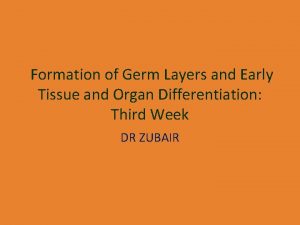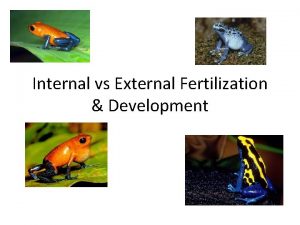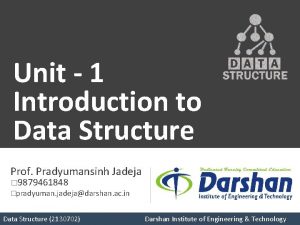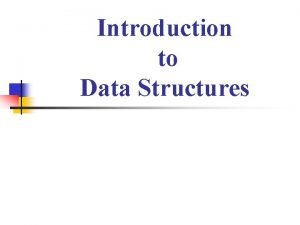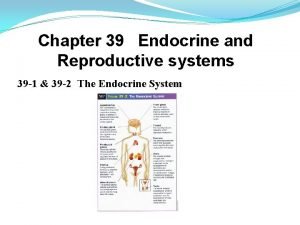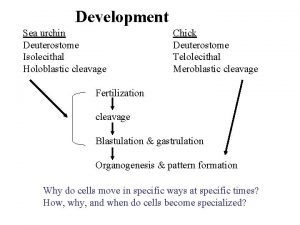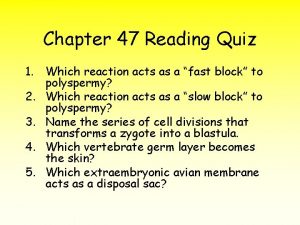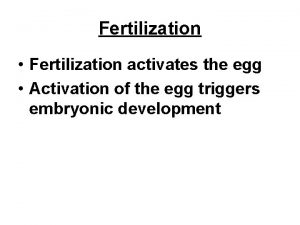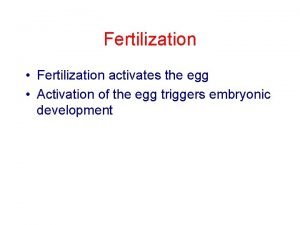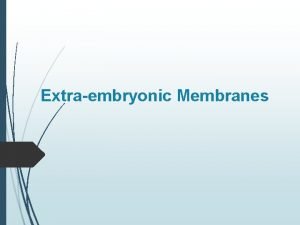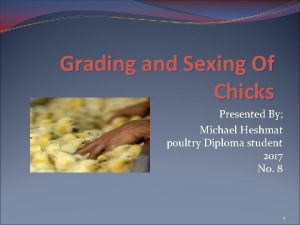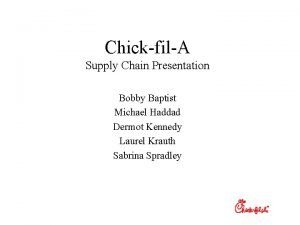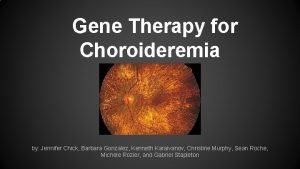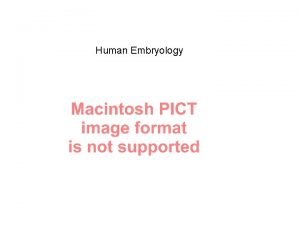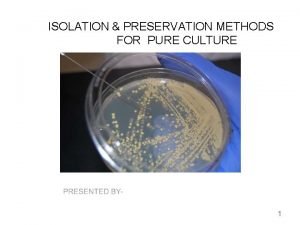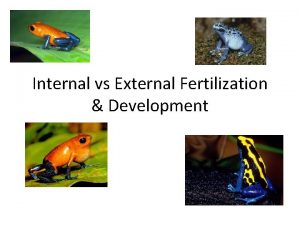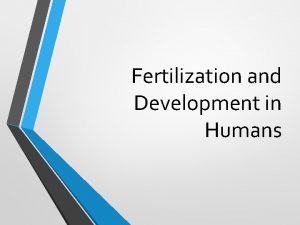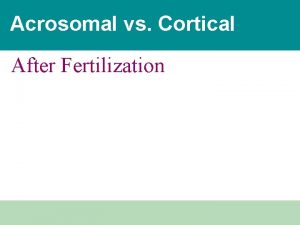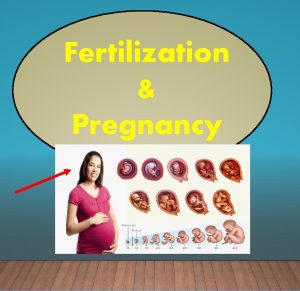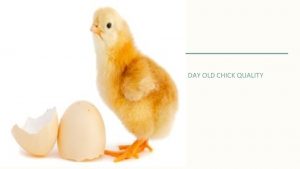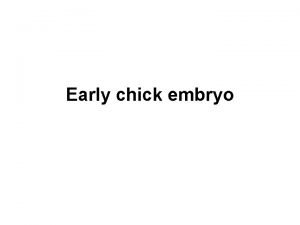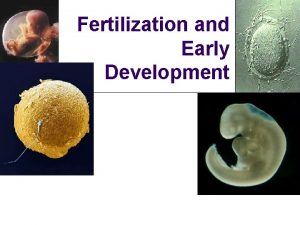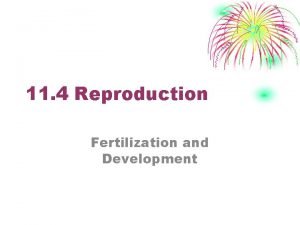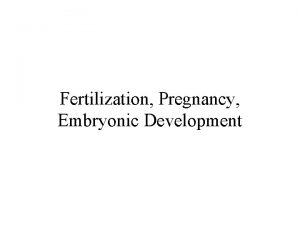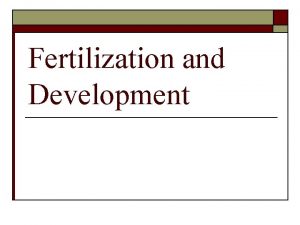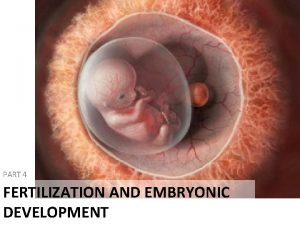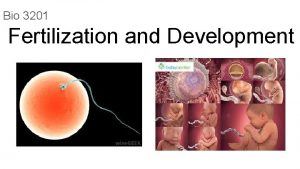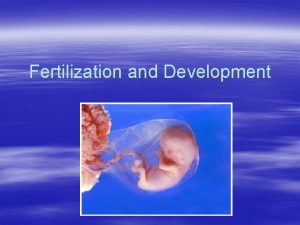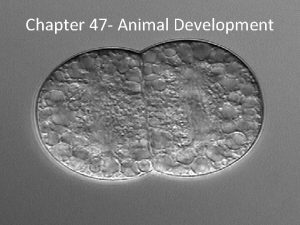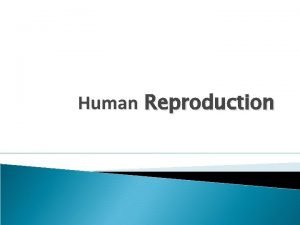Development of chick up to primitive streak Fertilization



























- Slides: 27

Development of chick up to primitive streak ü Fertilization ü Cleavage ü Blastulation ü Gastrulation Endoderm) (Ectoderm, Mesoderm & ü Fate Map ü Formation & Development of Primitive streak

• Fertilization: • Fertilization is internal. • Copulation precedes fertilization & is said to be cloacal kiss. • Spermatozoa may survive for two weeks in oviduct. • The ovum enters the oviduct; it is surrounded by many spermatozoa. • Several spermatozoa may enter the egg. • This condition is polyspermy, but the nucleus of one sperm fuses with the egg. • Fertilization occurs in the uppermost portion of oviduct.

• The fertilized egg on reaching the middle part of oviduct (magnum) receives thin albumin in its anterior part and thick or dense albumin in posterior part. • The (Isthmus) portion of the oviduct secretes the shell membranes. • The uterus adds chalazae, chalaziferous albumin and narrow layer of thin albumin. • The shell is exclusively formed by the uterus.

• Cleavage or segmentation: Cleavage is incomplete or meroblastic (partial). In birds cleavage is also called discoidal. Cleavage commences immediately after fertilization. Cleavage starts in the upper part of oviduct. When cleavage begins the blastodisc is about 3 mm in diameter and 0. 5 mm thick. • Through series of cleavages the egg is then attains a blastula stage. • • •

• First Cleavage: - it is meridional. • Appears in the middle of the blastodisc. • It does not reach the margin and lower portion of the disc. • It results in the production of 2 blastomeres, are incompletely separated. • Second Cleavage: - it is also meridional but at right angles to the first one. • It results in the production of four blastomeres.

• Third cleavage: -the third cleavage furrows are two • • in number. They are vertical to the second cleavage. Resulting in to the formation of eight blastomeres. Fourth Cleavage: - it is also a vertical, circular in nature. Resulting in the formation of 16 blastomeres (8 central cells & 8 marginal cells). The egg takes about 24 hours to reach the cloaca. When egg arrives in cloaca it is in advance stage of cleavage. Cleavage from this point is irregular & rapid. The embryo reaches 256 celled stage rapidly.

• As a result of cleavage, new marginal cells are produced. • As the process of cleavage goes on, these marginal cells are added to the central cells; meanwhile more marginal cells arise. • In this way the central segmented area is continually increasing in diameter. • From this the cleaving blastodisc is called blastoderm. • A fluid begins to accumulate between this layer of cells & cytoplasm. • This forms a shallow space called blastocoel or segmentation or sub-germinal cavity.

• As the blastocoel is formed a single layer of central cells is formed above the cavity. • The horizontal cleavage furrow appears among the central cells. • This cleavage furrow is parallel to the surface. • As a result, the single layer of central cells is converted into two layers above the blastocoel. • Continued cleavage of a similar type establishes several strata of central cells.

• As cleavage proceeds, some of the nuclei from the dividing blastoderm area enter the uncleaved portion of the cytoplasm located around and below enlarging blastocoel. • These nuclei arrange themselves here and there in this cytoplasm. • This mass of cytoplasm is converted into a syncytial mass. • This syncytial cytoplasm is called Periblast tissue. • It is made up of two general areas peripheral periblast & central periblast. • The periblast tissue brings about nutritive contact between the yolk and the developing blastoderm.

• The peripheral periblast develops cell-boundaries. • The newly formed cells are added to the peripheral part of the cellular blastoderm. • The cells produced from periblast constitute the germ wall. The germ wall increases as more and more cells are produced from periblast. • As a result, the periblast itself is gradually exhausted. • The margin of blastoderm is pushed up over the yolk, the area is called margin of overgrowth. • They make an intimate contact with yolk i. e. zone of junction.


• Blastula: • It is the embryonic stage formed by cleavage. • The blastula of chick is in the form of disc. , hence called disco-blastula. • It is formed of three or more layers of blastomeres, followed by a cavity called blastocoel. • The central portion of blastoderm is free from yolk and the peripheral part is closely adherent to the yolk. • Hence under microscope the central part looks transparent and peripheral part looks opaque. • The central part is area pellucida and the peripheral part is area opaca.

Gastrulation • Gastrulation is the development of multilayered gastrula from blastula. • During gastrulation, the blastomeres are arranged into three layers, namely ectoderm, endoderm & mesoderm, (germ layers). • During gastrulation the blastomeres move from one place to other. The movement of cells during gastrulation is called morphogenetic movements. • These movements bring out a definite shape to the embryo. • The morphogenetic movements are of two types epiboly & emboly.

• Epiboly is the movement of cells on the surface of the embryo. Convergence, extension, are epibolic movements. • Emboly is the movement of cells into the embryo. Involution, divergence, infiltration, delamination are embolic movements. • Events in Gastrulation: • There are two steps in gastrulation… • 1. formation of endoderm and • 2. Formation of primitive streak and mesoderm.

• 1. Formation of Endoderm: • The endoderm or hypoblast develops as a single layer of cells inside the blastocoel. After formation of endoderm the upper layer is called epiblast or ectoderm. • The new cavity is formed below endoderm is archenteron. • There are different theories regarding the formation of endoderm.

(A) Infiltration Theory: • This theory was formulated by Peter (1983). • According to this theory, some cells in the blastoderm are loaded with yolk and hence are heavier. • These cells detach and fall into the blastocoel near the posterior end of blastoderm. • From here these cells migrate forward and remain one behind the other and form a single layer of cells called endoderm.

(B) Polyinvagination Theory: • This theory was proposed by Pasteels (1945). • This theory is very much similar to that of the above theory but the difference is that the heavier cells fall into blastocoel all over the pellucid area of the blastoderm. (C) Delamination Theory: • This theory was proposed by Spratt (1945. • Delamination (de= separation, lamina= layer). • According to this theory the lower layer of blastomere separates from the upper layers by splitting. • As a result a cavity increases in its size, the lower

• Layer swings downwards. This layer is the endoderm. • The upper layer constitute the ectoderm. (D) Theory of Involution: • This theory was proposed by Patterson (1909). • According to this theory a slit-like opening appears at the posterior margin of blastoderm. • Through this opening the blastoderm cells involutes (roll) into the blastocoel. • These cells migrate towards the anterior end arrange themselves as a single layer of endoderm. • This theory was not widely accepted.

(E) Theory of Invagination: • This theory was proposed by Jacobson (1938). • According to this theory, the posterior end of the blastoderm invaginate into the blastocoel to form a small pocket. • The cavity of the pocket is the archenteron and floor and the roof become the endoderm. • By further continuation of invaginating cells endoderm gradually extends towards the anterior end.

• Fate map or Fate of Germ layers: • All the tissues and organs of adult vertebrate body develop from the three germ layers which have established quite earlier in the embryo. • This gives us an idea what structures will derive from the three primary germ layers. • The organ forming areas can be marked after the formation of hypoblast. • Therefore the embryo development of chick is of indeterminate type.

• The hypoblast is composed exclusively of endoderm. • The epiblast has most of the organ forming cells. • The area opaca develops into extra-embryonic membranes and blood vessels. • The area pellucida develops into epidermal ectoderm, neuroectoderm, prechordal cells, notochordal cells and mesoderm cells. • Behind this there is a crescent which develops into notochord. • Immediately behind the notochordal area, there is a small area which develops into prechordal plate. • On either side & behind prechordal plate lies mesoderm.

• It is necessary that the production of specific areas or territories of cells, each having the tendency to differentiate into a specific structure, and the axiation of these areas along with the primitive axis of the embryo are two main functions of gasrulative process.

Formation of primitive streak and mesoderm • Primitive streak is a thickened tower-like area of chick blastoderm. • It lies anterio-posteriorly on the surface of the blastoderm. • It is a temporary structure & well developed in 18 hrs of incubation. • The thickening is due to the convergence of the cells of blastoderm towards the centre. • In the early stage primitive streak is broad and short and is called short primitive streak & gradually extends forward & reaches the middle of the blastomeres.

• The mature primitive streak is called definitive streak. • The primitive streak functions as a pathway through which the organ forming cells migrate into the interior of embryo. • It is developed by continuous convergence of cells towards it. The cells invaginate individually, the process is immigration. • As the cells designed to become notochord and mesoderm migrate into the interior of the embryo, the material which forms the primitive streak becomes gradually exhausted.



 Primitive streak gives rise to
Primitive streak gives rise to Gastrulation and neurulation
Gastrulation and neurulation Internal vs external fertilization
Internal vs external fertilization How to calculate time complexity in data structure
How to calculate time complexity in data structure Classification of data structures
Classification of data structures Chapter 39 endocrine and reproductive systems
Chapter 39 endocrine and reproductive systems 33 hour chick embryo
33 hour chick embryo 72 hour chick embryo
72 hour chick embryo Clay family food high relay odd one out
Clay family food high relay odd one out True coelom
True coelom Syllables v/cv vc/v penguin chick
Syllables v/cv vc/v penguin chick Fertilization
Fertilization Arrogant connotation
Arrogant connotation Chick lane
Chick lane Penguin chick vocabulary
Penguin chick vocabulary Chick-fil-a organizational structure
Chick-fil-a organizational structure Chick's law formula
Chick's law formula Chick-n-gravy dinner line case study
Chick-n-gravy dinner line case study Function of extraembryonic membrane
Function of extraembryonic membrane 48 hours chick embryo diagram
48 hours chick embryo diagram Vent sexing a chicken
Vent sexing a chicken Chick-fil-a supply chain flow chart
Chick-fil-a supply chain flow chart Penguin chick by betty tatham
Penguin chick by betty tatham Jennifer chick
Jennifer chick Penguin chick main idea and details
Penguin chick main idea and details 33 hour chick embryo whole mount
33 hour chick embryo whole mount Delamination in plastic injection molding
Delamination in plastic injection molding Isolation and preservation method of pure culture
Isolation and preservation method of pure culture
